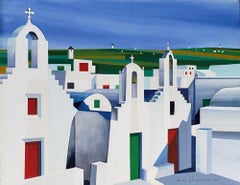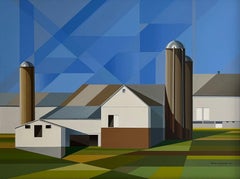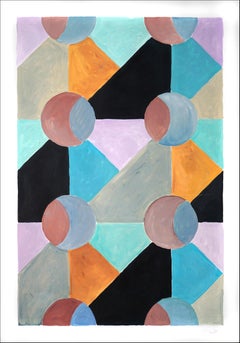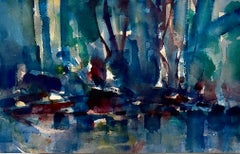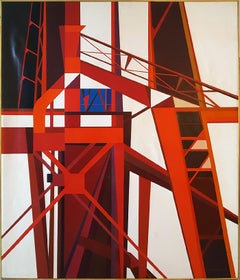Edmund Lewandowski Art
American, 1914-1998
Regarded as a leading American precisionist and exemplary arts educator, Edmund D. Lewandowski once explained that his “overwhelming desire . . . through the years has been to record the beauty of man-made objects and energy of American industry,” a goal he successfully achieved in a career that spanned five decades and numerous locations, including the American Midwest, South, and New England. Born to Polish parents in Milwaukee, Wisconsin, Lewandowski attended the Layton School of Art, studying under regionalist artist Gerrit Sinclair. Inspired by Sinclair’s modern style and urban subjects, Lewandowski’s early paintings reflect a similar approach that would later evolve to industrial themes executed in a hard-edged precisionist manner. His most well-known subjects include chemical plants, shipyards, factories, farms, and oil rigs.
Following graduation, Lewandowski worked as a public school teacher and commercial artist while pursuing his painting. His career took a significant step forward when, in 1936, his work caught the eye of the progressive art dealer Edith Halpert, who offered him representation at her celebrated Downtown Gallery in New York City. A key figure in modern art, Halpert encouraged Lewandowski to experiment with Precisionism and to remain in Milwaukee. In 1937, Lewandowski met Charles Sheeler, considered a leader in the American Precisionist movement, whose style would most significantly influence the younger artist’s career. Through his association with the Downtown Gallery and the work he executed for the Federal Art Project between 1936 and 1939, Lewandowski attracted important critical notice and was included in exhibitions at such notable institutions as the Metropolitan Museum of Art, Museum of Modern Art (Magic Realism exhibition), and Art Institute of Chicago during the 1940s alone. At the Downtown Gallery, he exhibited alongside other artists such as Charles Demuth, Georgia O'Keeffe, Ralston Crawford, George Ault, and Niles Spencer.
Following military service as an Air Force mapmaker and camouflage artist from 1942–1946, Lewandowski joined the faculty of his alma mater, the Layton School of Art, in 1947. From that time on, he divided his time between creating art and teaching another generation of aspiring artists. His teaching career took him to institutions throughout the United States, including Florida State University. Following his tenure at Florida State, Lewandowski returned to Layton as its director, remaining until 1972. Throughout these years, the artist would create and exhibit works on paper and canvas, as well as execute commissioned large-scale mosaic murals. In 1973, Lewandowski joined the faculty at Winthrop University in Rock Hill, South Carolina, where he would serve as the art department chair until his retirement in 1984.
Edmund Lewandowski’s art showcases an exacting technical skill honed in his early training and advanced by his relationship with Sheeler. His ultrarealistic works painted in watercolor, gouache, or oil range from early farmscapes to industrial scenes and marine subjects, a variety that reflects the artist’s constant quest for aesthetic evolution. Today, Lewandowski’s work can be seen at prestigious national museums.(Biography provided by Lincoln Glenn)
to
3
1
2
1
1
1
1
Overall Height
to
Overall Width
to
1
1
1
1
1
1
1
1
3
1
1
3
6,886
3,209
2,514
1,217
3
2
2
1
1
Artist: Edmund Lewandowski
Sail Boats
By Edmund Lewandowski
Located in Miami, FL
A precise and exact rendering and meticulous spacial arrangement are on full display in Lewandowski's this later work.
The work looks better in person. The artwork is in pristine co...
Category
1990s Photorealist Edmund Lewandowski Art
Materials
Watercolor, Gouache
Mykonos Church Landscape
By Edmund Lewandowski
Located in Miami, FL
A vibrant example of the artist's precisionist style where a tight semi-abstract geometric composition is inspired by architecture and is reduced to simplified geometric shapes with...
Category
1960s Abstract Geometric Edmund Lewandowski Art
Materials
Gouache, Board
Amish Farmscape #3
By Edmund Lewandowski
Located in Los Angeles, CA
Amish Farmscape #3, 1984, oil on canvas, 40 x 30 inches, signed and dated lower right; signed, dated, and titled verso
About the Painting
Amish Farmscape #3 is part of a multi-painting series of barns completed in the early 1980s for an exhibition at New York’s prestigious Sid Deutsch Gallery. Lewandowski painted this work at an important point in his career. It was the first major project undertaken by Lewandowski after his retirement from serving as the Chairman of Winthrop University’s Art Department, the last academic position he held after teaching for nearly thirty years. Lewandowski had been inspired to work on the series by a visit to Lancaster County, Pennsylvania. Like his friend and mentor, Charles Sheeler, Lewandowski had always been fascinated by vernacular architecture and the Amish barns of Pennsylvania brought back memories of rural scenes Lewandowski had painted in the Midwest much earlier in his career. Amish Farmscape #3 is a strong example of Lewandowski’s late precisionist work. The complexity of the composition and Lewandowski’s technical acumen are on full display. Being relieved of the burdens of teaching and administering a university art department likely allowed Lewandowski greater freedom and most importantly more time to complete the Amish Farmscape series. Although Lewandowski’s brand of precisionism changed throughout the years, he never deviated from the core tenets of the Immaculate School artists. In this work, we see simplified and flattened forms, the use of ray-lines to define light and space, the elimination of extraneous details, a polished almost machine-like finish, and the complete lack of visible brushstrokes, all hallmarks of the precisionist painters. Lewandowski was the last of the 20th century precisionists and in Amish Farmscape #3, we see just how successfully he continued to work in this style until his death in 1998.
About the Artist
Edmund Lewandowski was among the best of the second-generation precisionist painters. He was born and raised in Milwaukee, Wisconsin and studied at the Layton School of Art with Garrett Sinclair. Lewandowski achieved early success when in 1936 two of his watercolors were shown at the Phillips Collection as part of a Federal Art Project exhibition. Then, in 1937, his work was first exhibited at Edith Halpert’s Downtown Gallery which represented Lewandowski into the 1950s. Under Halpert’s guidance, Lewandowski continued to explore watercolor as his main medium during the 1930s and 1940s, since the gallery already represented Charles Sheeler, who worked primarily in oils. Sheeler became Lewandowski’s major influence as the primary leader of the ill-defined, but very recognizable Immaculate School artists, which included other Downtown Gallery painters, Niles Spencer, George Ault, and Ralston Crawford, as well as Charles Demuth and Preston Dickinson, both of whom died at a young age and had been represented by the Charles Daniel Gallery. Sheeler is credited with giving Lewandowski technical advice on how to make his paintings more precise and tightly rendered and by all accounts, Sheeler was a fan of Lewandowski’s work. Through the Downtown Gallery, Lewandowski’s paintings were accepted into major national and international exhibitions and purchased by significant museums and collectors. Franklin and Eleanor Roosevelt and Nelson Rockefeller acquired works by Lewandowski. He was included in the Museum of Modern Art’s important 1943 exhibition, American Realists and Magic Realists as well as juried exhibitions at the Whitney Museum of American Art, the Pennsylvania Academy of Fine Arts, and the Art Institute of Chicago. Lewandowski also completed commissions for magazines during the 1940s and 1950s, including several covers for Fortune. Throughout his career, Lewandowski explored urban and rural architecture, industry, machinery, and nautical themes. Looking back on his career, Lewandowski wrote, “My overwhelming desire as an artist through the years has been to record the beauty of man-made objects and energy of American industry on canvas. For as far back as I can recall, the cityscapes, farms and depictions of industrial power and technological efficiency has had a great attraction for me. I try to treat these observations with personal honesty and distill these impressions to a visual order.” Lewandowski is credited with extending precisionism to the Midwest and successfully continuing the style into the 1990s, three decades after Sheeler’s death and six decades after Demuth’s passing. Late in his career, Lewandowski enjoyed a resurgence of popularity as he was represented during the 1980s by New York’s Sid Deutsch and Allison Galleries...
Category
Mid-20th Century American Modern Edmund Lewandowski Art
Materials
Canvas, Oil
Related Items
Modernist Glass Window, Cold Blue and Mauve Pastel Geometric Patterns, Surreal
By Natalia Roman
Located in Barcelona, ES
These series of paintings by Natalia Roman gather their inspiration from geometric, minimalist shapes and paintings from the beginning of Modernism, with a special emphasis on Art De...
Category
2010s Abstract Geometric Edmund Lewandowski Art
Materials
Oil Pastel, Oil, Acrylic, Watercolor, Gouache
No Reserve
H 40 in W 28 in
Modernist Abstract Expressionist Watercolor Painting Bauhaus Weimar Pawel Kontny
By Pawel Kontny
Located in Surfside, FL
Abstract watercolor composition bearing the influence of the earlier color-block compositions of Paul Klee.
Pawel August Kontny, (Polish-German-American artist) He was born in Laurahuette, Poland, in 1923, the son of a wealthy pastry shop owner. In 1939 he began studying architecture in Breslau where he was introduced to the European masters and to the work of some of the German Expressionists, soon afterward banned as "degenerate artists" and removed from museums throughout Germany by the Nazi regime. His studies were interrupted by World War II. Drafted into the German army, traveling in many countries as a soldier, he sketched various landscapes but in 1945, he was captured and held as a prisoner of war in Italy. After the war, he studied at the Union of Nuremberg Architects to help design buildings to replace ones destroyed in the war. He recorded his impressions of the local population and the landscapes through his watercolors and drawings. Pawel Kontny thereafter moved to Nuremberg, Germany, becoming a member of the Union of Nuremberg Architects and helping to rebuild the city's historic center. He soon decided to concentrate on his professional art career. He married Irmgard Laurer, a dancer with the Nuremberg Opera. Pavel Kontny 's career as an artist was launched with his participation in an all German exhibition, held at the Dusseldorf Museum in 1952. He held one-man shows in Germany, Switzerland and the United States. During his trip to the United States in 1960, Kontny became instantly enamored with Colorado, and decided to relocate to Cherry Hills with his wife and two children. He quickly established himself in the local art community, being affiliated for a time with Denver Art Galleries and Saks Galleries. His subject matter became the Southwest. During this time he received the Prestigious Gold Medal of the Art Academy of Rome. His extensive travel provided material for the paintings he did using his hallmark marble dust technique. he also worked equally in pastel, watercolor, charcoal and pencil-and-ink. in a style which merged abstraction and realist styles, influenced by Abstract Expressionist painting and South Western American landscapes. In the early 1960s he was one of only a few European-born professional artists in the state, a select group that included Herbert Bayer (1900-1985), a member of the prewar Bauhaus in Weimar and Dessau, Germany, and Roland Detre (1903-2001), a Hungarian modernist painter. As a Denver, Colorado resident, Pavel Kontny exhibited at galleries and museums throughout the United States, Germany and Japan. There, he was inspired by frequent trips to Native American pueblos in the Southwest, as well as by the study of the Plains Indians of Montana and Wyoming. Over the years Kontny had a number of students and generously helped young artist by hosting exhibitions at his Cherry Hills home. For many years he generously donated his paintings to support charitable causes in Denver. Influences during his European years included German pastelist C.O. Muller, German Informel painter Karl Dahmen and Swiss artist, Hans Erni. In the early 1950s his painting style showed the influence of the Die Brücke (The Bridge), a group of German expressionist artists formed in Dresden in 1905 who had a major impact on the evolution of modern art in the twentieth century in Germany. By the middle of the decade his style incorporated more referential abstraction and total abstraction, resulting in part from his study of Hans Hartung, a German artist based in Paris who exhibited his gestural abstract work in Germany. The American moon landing in 1969 inspired Paul Kontny...
Category
20th Century American Modern Edmund Lewandowski Art
Materials
Canvas, Oil
Southern Hemisphere Sunset, Squared Bauhaus, Pink Yellow Gradient, Fucsia Grid
By Natalia Roman
Located in Barcelona, ES
This abstract geometric acrylic painting is a vibrant and playful composition that draws inspiration from vintage Italian parasols. With a focus on bold, bright colors and clean line...
Category
2010s Abstract Geometric Edmund Lewandowski Art
Materials
Oil Pastel, Oil, Acrylic, Watercolor, Gouache
No Reserve
H 28 in W 28 in
Landscape with Ciociaria Shepherd, the Bridge over the Tiber river and Ruins.
By Paul Pascal
Located in Firenze, IT
Landscape with Ciociaria shepherd, the bridge over the Tiber river and the ancient ruins by Paul Pascal (1839-1905).
Around 1880.
Gouache on paper.
Dimensions with frame: cm 69 x...
Category
1880s French School Edmund Lewandowski Art
Materials
Paper, Gouache
Free Shipping
H 20.08 in W 27.17 in D 0.79 in
Fine Antique French Impressionist Painting View Of A Park with Stone Urn
Located in Cirencester, Gloucestershire
The artist:
Henri Aime Duhem (1860-1941) French *see notes below, signed
Title: The Parkland
Medium:
signed gouache on paper, loosely laid over card, ...
Category
19th Century Impressionist Edmund Lewandowski Art
Materials
Gouache
French Modernist Vivid Bright Fauvist Landscape Watercolor Gouache Painting
By Claude Hemeret
Located in Surfside, FL
signed lower right. size includes frame.
The French artist Claude Hemeret was born on May 23, 1929. After classical studies at the lycée du Parc Imperial in Nice, he started at the l...
Category
20th Century Post-Impressionist Edmund Lewandowski Art
Materials
Watercolor, Gouache
Fine Antique French Impressionist Painting Landscape with River Cow & Figure
Located in Cirencester, Gloucestershire
The artist:
Henri Aime Duhem (1860-1941) French *see notes below, signed
Title: The River Landscape
Medium:
signed gouache on paper, loosely laid over card, unframed
card: 9.7...
Category
19th Century Impressionist Edmund Lewandowski Art
Materials
Gouache
Waves and their Shadows, Bauhaus Geometric Patterns in Black, Primary Tones Hue
By Natalia Roman
Located in Barcelona, ES
This abstract geometric acrylic painting is a vibrant and playful composition that draws inspiration from vintage Italian parasols. With a focus on bold, bright colors and clean line...
Category
2010s Abstract Geometric Edmund Lewandowski Art
Materials
Oil Pastel, Oil, Acrylic, Watercolor, Gouache
Oasis in The Desert, Abstract Geometric Landscape in Green, Blue, Earth Tones
By Natalia Roman
Located in Barcelona, ES
This abstract geometric acrylic painting is a vibrant and playful composition that draws inspiration from vintage Italian parasols. With a focus on bold, bright colors and clean lines, the painting features intersecting shapes and patterns that evoke the cheerful, summery vibe of a day spent lounging in the shade of a colorful umbrella.
Details:
Title: Oasis in The Desert...
Category
2010s Abstract Geometric Edmund Lewandowski Art
Materials
Oil Pastel, Oil, Acrylic, Watercolor, Gouache
Rue Étienne Marcel, Paris, France
By Henri Grenier
Located in Atlanta, GA
One of my favorite French Fauvist painters, Henri Grenier (1882 - 1940), masterfully captures the energy of the turn-of-the-century Boulevard Saint-Germain in this exciting work on p...
Category
Early 20th Century Fauvist Edmund Lewandowski Art
Materials
Gouache
Modernist Colorado Oil Painting Abstract Cityscape Harbor Scene Pawel Kontny
By Pawel Kontny
Located in Surfside, FL
Urban landscape of city harbor, marine scene, (North Africa?) bearing the influence of the earlier color-block compositions of Paul Klee.
Modernist Cityscape 24" x 36" sight. oil on ...
Category
20th Century American Modern Edmund Lewandowski Art
Materials
Canvas, Oil
Fine Antique French Impressionist Painting Canal Tow Path with Children & Boats
Located in Cirencester, Gloucestershire
The artist:
Henri Aime Duhem (1860-1941) French *see notes below, signed
Title: The Canal
Medium:
gouache on paper, loosely laid over card, unframed
...
Category
19th Century Impressionist Edmund Lewandowski Art
Materials
Gouache
Previously Available Items
Blast Furnace
By Edmund Lewandowski
Located in Miami, FL
This work is monumental in size and will make a signture statement in any room.
signed lower right and dated 1975; also signed and titled on the stretcher 70" x 60" Frame: 71" x 60.7...
Category
1970s Abstract Geometric Edmund Lewandowski Art
Materials
Oil
Edmund Lewandowski art for sale on 1stDibs.
Find a wide variety of authentic Edmund Lewandowski art available for sale on 1stDibs. If you’re browsing the collection of art to introduce a pop of color in a neutral corner of your living room or bedroom, you can find work that includes elements of purple and other colors. You can also browse by medium to find art by Edmund Lewandowski in paint, gouache, watercolor and more. Much of the original work by this artist or collective was created during the 20th century and is mostly associated with the Photorealist style. Not every interior allows for large Edmund Lewandowski art, so small editions measuring 20 inches across are available. Customers who are interested in this artist might also find the work of George G. Adomeit, Franklin Jonas, and August Mosca. Edmund Lewandowski art prices can differ depending upon medium, time period and other attributes. On 1stDibs, the price for these items starts at $14,000 and tops out at $30,000, while the average work can sell for $22,000.

